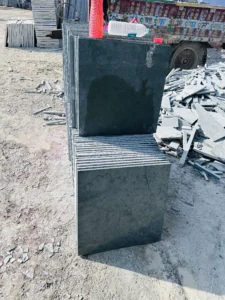Rajasthan’s Kota Stone: A Timeless Blend of Beauty and Durability
In the heart of Rajasthan, India, lies the town of Kota, famous for a natural stone that has not only shaped the region’s economy but also left an indelible mark on India’s architectural heritage. Kota stone, known for its unique properties and aesthetic appeal, has been a preferred choice in construction and design for centuries. This article delves into the characteristics, uses, history, and current trends surrounding Rajasthan’s Kota stone.
Characteristics
Kota stone is a type of fine-grained limestone, quarried predominantly in Kota and its surrounding regions in Rajasthan. Its hallmark is the rich, earthy tones that range from greys to browns, with subtle shades that vary with each stone. It is renowned for its hardness, durability, and ability to resist water absorption. The non-slippery texture and natural look make it a popular flooring material.
Historical and Cultural Significance
The use of Kota stone in India dates back centuries. It has been a staple in traditional Indian architecture, particularly in Rajasthan, where it has been used in palaces, temples, and havelis. Its affordability and durability made it a common material for the flooring in courtyards and public spaces.
Extraction and Processing
The extraction of Kota stone from the quarries involves a meticulous process that ensures minimal damage to the stone. Once extracted, it is cut into slabs and then polished, if desired, to give it a more refined finish. The industry provides employment to thousands in the region, making it an essential part of the local economy.
Contemporary Use and Trends
In contemporary architecture and interior design, Kota stone has seen a resurgence in popularity. It’s favored for its rustic, natural appearance that lends a warm, organic feel to spaces. It’s used in a variety of settings, from residential to commercial, and is particularly popular for outdoor spaces like patios and gardens due to its weather-resistant qualities.
Sustainability and Environmental Considerations
One of the key aspects of Kota stone that makes it a material of choice in modern sustainable architecture is its minimal environmental impact compared to manufactured flooring options. It’s a natural stone that doesn’t require extensive processing or chemicals for its finishing. However, the quarrying process does raise environmental concerns, leading to increased awareness and efforts towards sustainable quarrying practices.
Challenges and the Future
Despite its popularity, the Kota stone industry faces challenges, particularly in the areas of consistent quality control and environmental management. There’s a growing need for technological upgrades in the extraction and processing stages to ensure sustainability. Looking ahead, the Kota stone industry is poised for growth, with a focus on sustainable practices and innovative uses in architecture and design.
Conclusion
Rajasthan’s Kota stone is more than just a building material; it’s a testament to the region’s geological wealth and its historical and cultural legacy. As it adapts to modern needs and environmental concerns, Kota stone continues to be a symbol of durability, beauty, and the timeless charm of Rajasthan’s architectural heritage. Whether in traditional settings or contemporary designs, its presence is a reminder of the harmony between nature and human craftsmanship.


